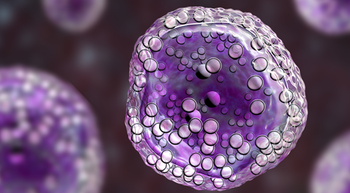
- December 2014
- Volume 8
- Issue 9
Talking With Christopher Friese About Chemotherapy Safety
In September of this year, the National Institute of Occupational Safety and Health (NIOSH) announced a $2.3 million research grant involving 11 of the nation's leading cancer centers.
In September of this year, the National Institute of Occupational Safety and Health (NIOSH) announced a $2.3 million research grant involving 11 of the nation’s leading cancer centers. The 4-year initiative will examine exposure risks during the administration of chemotherapy and other hazardous drugs and identify effective strategies to combat these risks.
What’s notable about this award is that the focus is squarely on oncology nurses, “the single largest group of oncology care providers,” noted Christopher R. Friese, PhD, RN, AOCN, FAAN, assistant professor at the University of Michigan School of Nursing, who will be leading the new Drug Exposure Feedback and Education for Nurses’ Safety (DEFENS) study.
Oncology Nursing News interviewed Friese to discuss the NIOSH award and the findings from research he led examining antineoplastic exposure in a high-volume ambulatory infusion center. For that study, oncology nursing personnel were asked to complete a survey after a drug spill event and also to provide urine samples over an 8-hour period. The researchers found detectable levels of drugs in the samples of nurses both with and without a reported spill.1
What was the impetus for the study?
We wanted to follow up on findings from a paper-based survey asking nurses if they had been exposed to chemotherapy in the last year.2 There is always this problem in research of self-reporting. To obtain a more direct measure of the problem, we decided to collect biologic specimens that would confirm and quantify the degree to which nurses had been exposed.
What were the most significant findings?
We found that nurses are exposed to hazardous drugs and that we can measure hazardous drug levels after an acute exposure or spill, but also in the environment, including surfaces that are contaminated with drugs from old spills or faulty handling practices. Thus, there are two threats to oncology nurses: the first is during an acute spill if they’re not wearing their personal protective equipment (PPE), and the second is the sort of day-to-day faulty handling practices that can lead to an accumulation of surface contamination. A lot of these drugs have chemical properties that lead them to stick to floors, chairs, and countertops.
Second, though not a statistically significant finding, we saw a trend that spills are more common among more experienced nurses, which suggests that their level of vigilance may be lower because they have been practicing for so long. They may feel that nothing bad has happened to them yet, so nothing bad is going to happen now; their perceived threat of the problem is likely lower, and their safeguards may be lower. For managers and educators, it’s important to realize that training and reinforcement of safe practice is important, not just for new nurses entering the profession, but for those experienced nurses on whom we may not be focusing our attention.
Third, we also saw a trend, also not statistically significant due to the small sample size, that the work environment for nurses matters; when nurses reported higher workloads and lower performance on safety behaviors, spills were also higher.
Your study reported that 60% of the participants had either no or a low level of concern about spills. Did that surprise you?
There is a perception in the field that while this is a known hazard, the health hazards are minimal. What needs to be understood is that it’s the cumulative exposure that’s so difficult. We have a radiation badge for people who work with x-rays. When they turn the badge in, it’s monitored, and workers with high levels are reassigned. We don’t have a similar mechanism to measure cumulative exposure to chemotherapy in the oncology nurse. It’s the daily low exposure that poses the greatest threat to nurses. The low level of concern is not surprising, but it is still alarming. It means we have a long way to go to educate nurses on the health hazards of exposure.
Also worth noting is that increasingly, nurses are handling these drugs who are not oncology nurses and have far less training and understanding about these agents. We’re working with the American Nurses Association and others on developing a comprehensive policy that would help these nurses as well.
The study also found that use of PPE was not optimal. What accounts for this?
One explanation is that the policies in place were not quite clear to nurses as to when, where, and how they should be wearing PPE in the outpatient setting where the volume is high, and nurses are dealing with multiple patients, often at the same time. These data helped us to have a really clear conversation with nurses about what they should be doing.
Based on these findings and other research to date, what is necessary to improve safe handling practice?
Ideally, we want a multilayered strategy where we’re using the best technology and building on nurses’ knowledge of the potential hazards, so that we’re doing whatever we can to minimize the risks. This includes making sure the environment is uncluttered, that the pumps work, that the patient understands what’s going on and they’re being monitored so they’re not dislodging the tubing, and then making sure the PPE is in place so that in case all else fails, the nurse is still adequately protected.
Finally, it is important for nurses to report events to their superiors. This study found that spills were not reported to risk management, so the traditional approach of learning from our mistakes would not have happened if this study were not taking place. There may be some “blame and shame” going on, with nurses reluctant to report spills, seeing it as a reflection on their personal practice. We know, however, that this is a multifactorial problem: the ergonomics of the suite, the volume, being pressed for time, equipment, patient variables—all of this comes together, and unless we report these events and learn from them, we’re not going to improve on the problem.
References
- Friese CR, McArdle C, Zhao T, et al. Antineoplastic drug exposure in an ambulatory setting: a pilot study [published online ahead of print May 14, 2014] Cancer Nurs.
- Friese CR, Himes-Ferris L, Frasier MN, et al. Structures and processes of care in ambulatory oncology settings and nurse-reported exposure to chemotherapy. BMJ Qual Saf. 2012;21(9):753-759.
Articles in this issue
almost 11 years ago
Death With Dignityalmost 11 years ago
Navigating the New Landscape of Cancer Geneticsalmost 11 years ago
Managing Sickle Cell Disease: Lessons From Our Comprehensive Cancer Centeralmost 11 years ago
Fertility Preservation in Breast Cancer Survivorsalmost 11 years ago
"Oh, and by the way..." A Lynch Syndrome Story

















































































